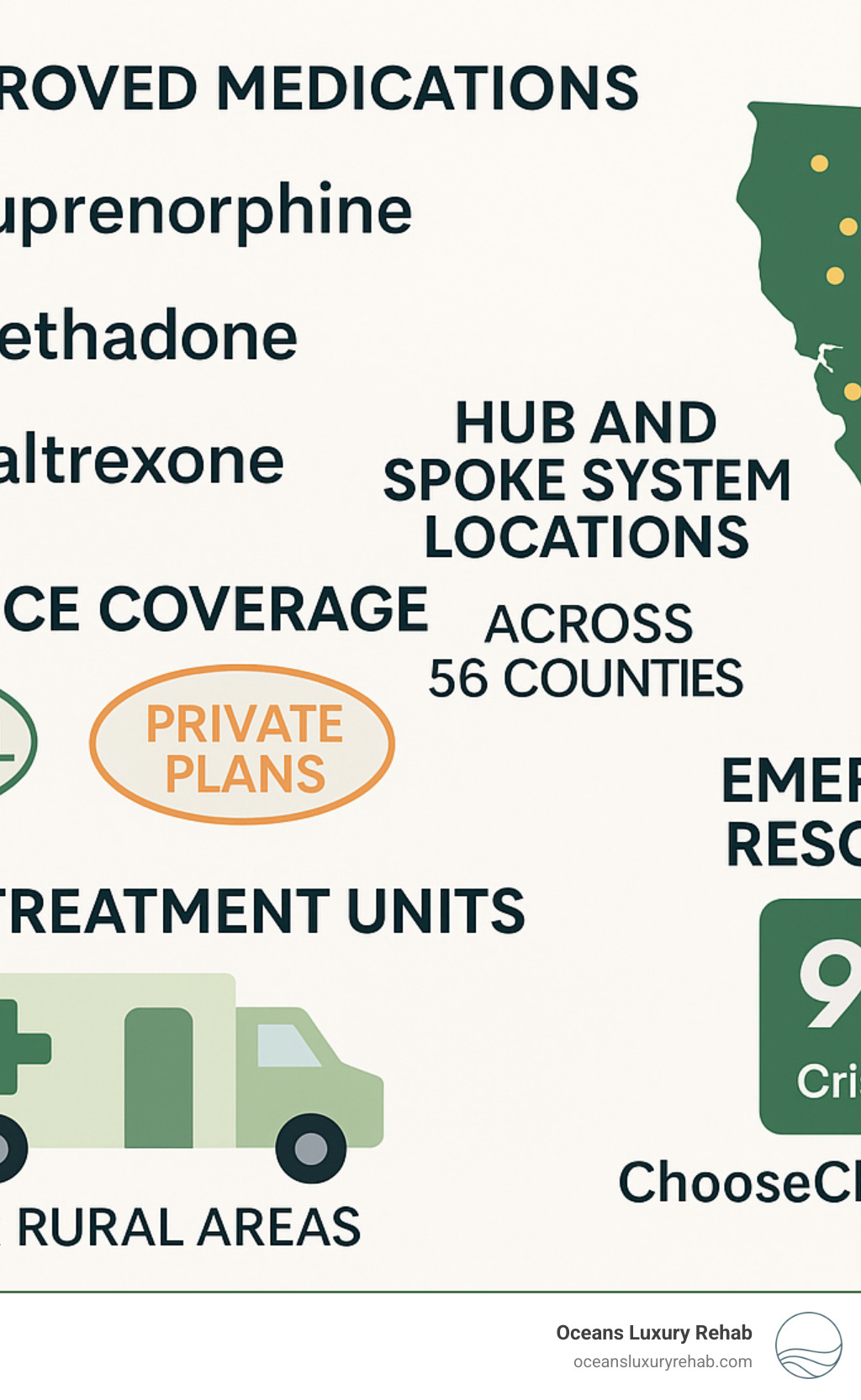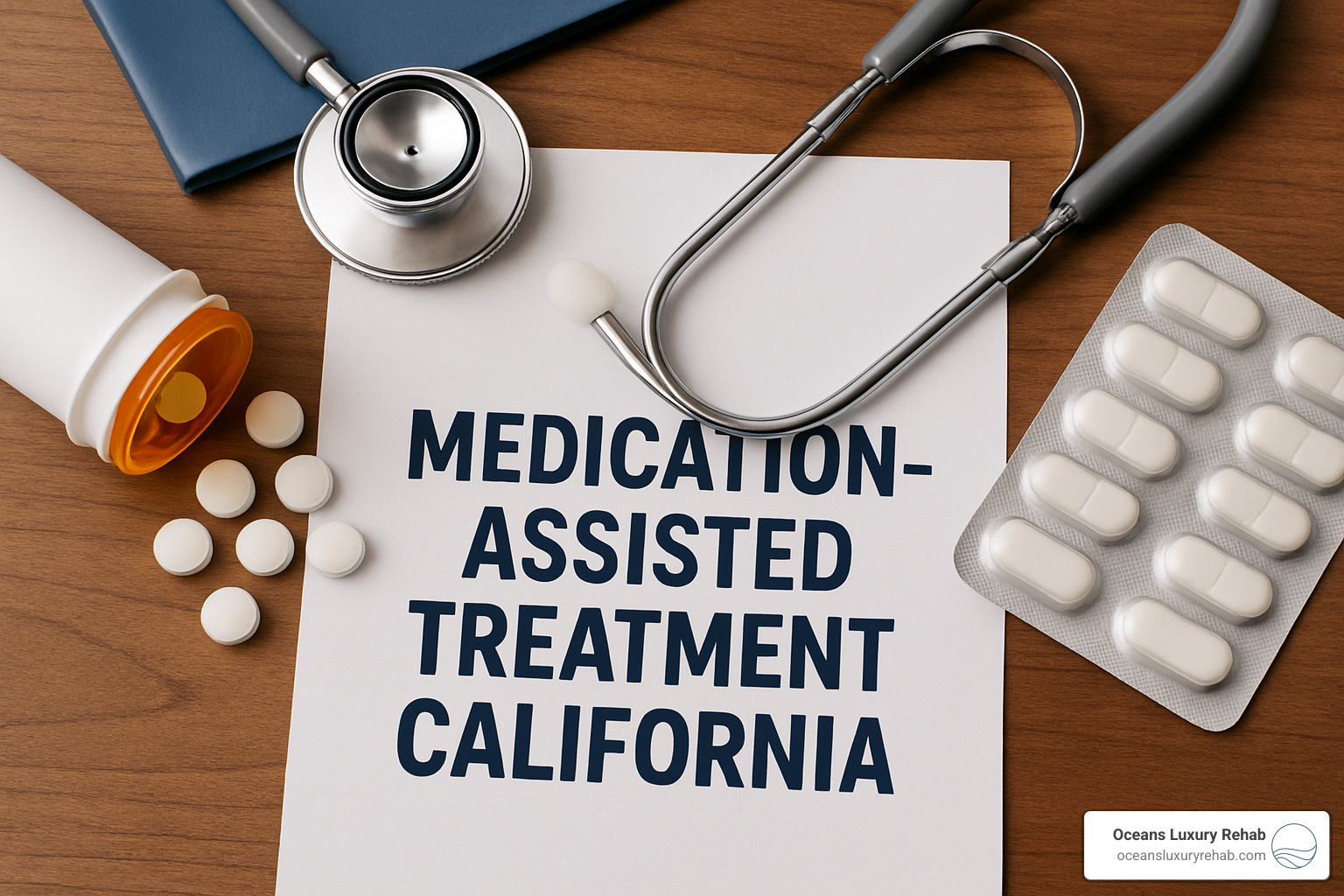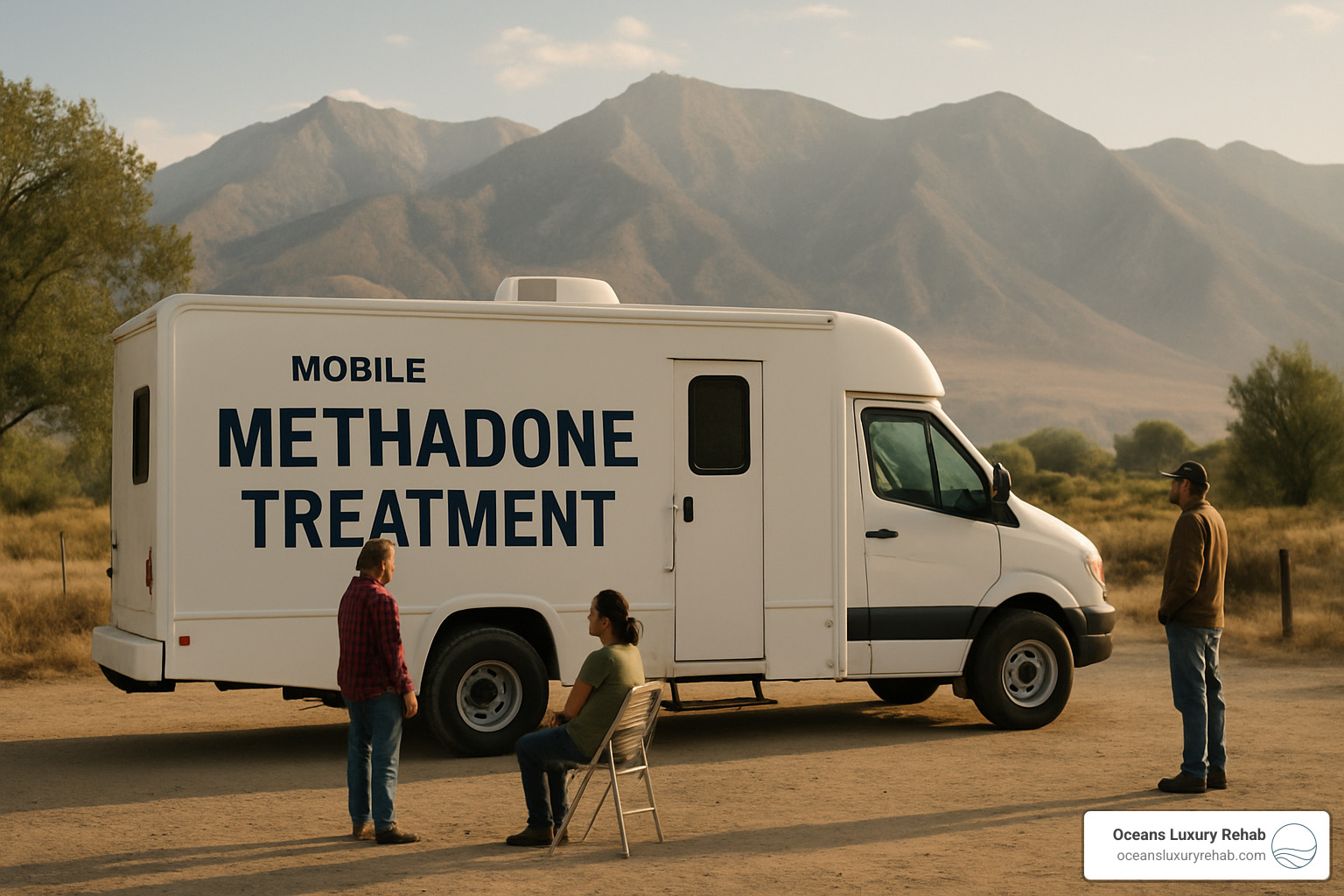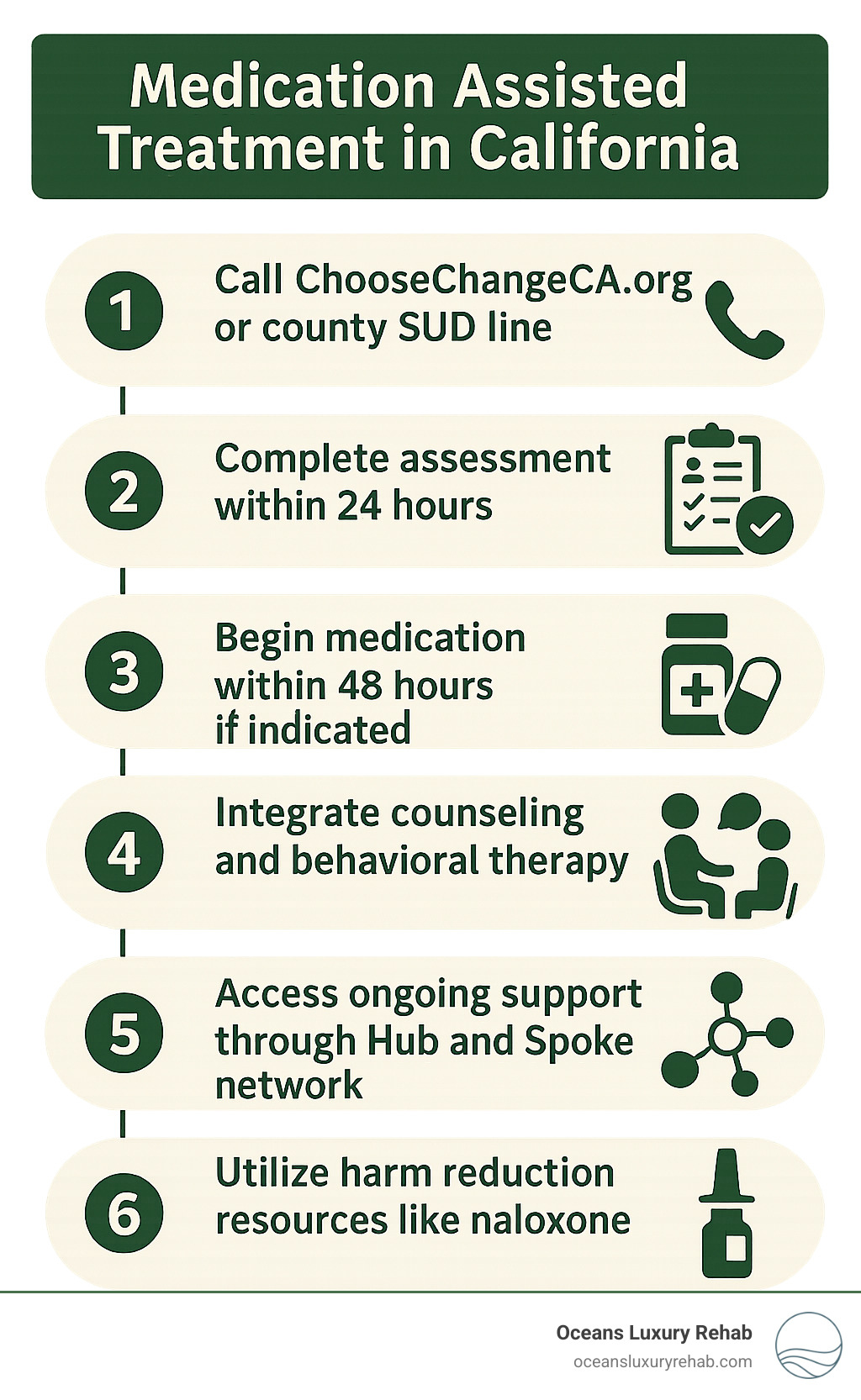Why California’s Overdose Crisis Demands Immediate MAT Solutions
Medication assisted treatment california has become a critical lifeline as the state faces an unprecedented overdose crisis, with over 10,000 deaths occurring from October 2020 through September 2021. This whole-patient approach combines FDA-approved medications with counseling and behavioral therapies to treat opioid and alcohol use disorders effectively.
Quick Facts About MAT in California:
- Three FDA-approved medications: Buprenorphine, methadone, and naltrexone for opioid use disorder
- Coverage: Medi-Cal and most insurance plans cover MAT services under California’s Mental Health Parity Act
- Access: 450+ community partners across 56 counties provide MAT services
- Funding: Over $118 million invested in expanding MAT access statewide
- Success rates: Patients staying in treatment 6+ months show dramatic reduction in illicit drug use
- Emergency help: Call 988 for crisis support or visit ChooseChangeCA.org to find providers
The state’s response includes the Hub and Spoke System, connecting specialized narcotic treatment programs with primary care providers, and the MAT Access Points Project, which has supported thousands of individuals across rural and urban communities. Fentanyl now accounts for 53% of overdose deaths—a 316% increase since 2019—making evidence-based treatment more urgent than ever.
As Clint Kreider, a Clinical Psychology specialist with 5 years in addiction treatment, I’ve witnessed how medication assisted treatment california transforms lives when combined with proper counseling and support systems.

Medication Assisted Treatment California: Statewide Landscape & Access

California has built one of the most comprehensive treatment networks in the country. The MAT Access Points Project has invested over $118 million to support more than 450 community partners across all 56 counties, serving both urban centers and rural communities that once had limited access to life-saving treatment.
Over 50% of patients who maintain medication treatment for six months or longer see dramatic improvements, including fewer overdoses, reduced criminal activity, better employment prospects, and family reunification.
| Medication | Primary Use | How It’s Taken | Key Benefits |
|---|---|---|---|
| Buprenorphine | Opioid Use Disorder | Under the tongue daily | Reduces cravings, safer from overdose |
| Methadone | Opioid Use Disorder | Liquid or tablet daily | Blocks euphoric effects, prevents withdrawal |
| Naltrexone | Opioid & Alcohol Use Disorder | Pill or monthly shot | Blocks effects of opioids and alcohol |
How Medication Assisted Treatment California Works
MAT medications work by normalizing brain chemistry without the harmful effects of street drugs. When combined with counseling, the medication quiets cravings and withdrawal symptoms so people can focus on therapy and recovery work.
Scientific research on MAT effectiveness consistently shows this whole-patient approach works better than other treatments, with people staying in treatment longer and experiencing better outcomes.
Medications and Coverage
California approves all FDA-approved medications for substance use disorders. Buprenorphine has become widely accessible since California removed special licensing requirements—any doctor with DEA registration can now prescribe it. Methadone remains the gold standard for severe addiction, while naltrexone blocks opioid receptors entirely.
For alcohol addiction, California offers acamprosate, disulfiram, and naltrexone. Naloxone is available without prescription at most pharmacies as the life-saving overdose antidote.
California’s Mental Health Parity Act ensures insurance companies treat addiction like other medical conditions. Medi-Cal provides comprehensive MAT coverage, and Senate Bill 184 requires all licensed addiction facilities to provide MAT or solid referral systems.
Under DHCS regulations, facilities must conduct MAT assessments within 24 hours and start treatment within 48 hours when recommended. For comprehensive care in a luxury setting, understanding drug and alcohol rehab options can help you find programs that integrate MAT with premium amenities.
Finding & Integrating MAT Programs Across California

California’s innovative approach brings medication assisted treatment california directly to communities through mobile units, jail programs, and tribal services. Over 31,700 individuals have received MAT while incarcerated in county jails across 36 California counties, ensuring recovery doesn’t wait for release.
State-Supported Networks
The Hub and Spoke System connects specialized treatment centers with community providers, investing over $65 million in grants to 91 organizations. Scientific research on Hub-and-Spoke shows how this model allows people to start treatment at specialty centers and transition to local community health centers for ongoing care.
Mobile narcotic treatment programs serve rural communities with fully equipped treatment centers on wheels. The MAT in Jails and Drug Courts Learning Collaborative ensures people don’t choose between legal consequences and medical treatment, while Tribal MAT programs receive dedicated Tele-MAT services and culturally responsive care.
Finding Providers and Resources
Locating services is simple through ChooseChangeCA.org, which filters by location, insurance, and services. The TreatmentAtlas and County SUD access lines provide additional search tools and human guidance.
The 2-1-1 system works 24/7 for treatment referrals and support services, while California’s Substance Use Line at 844-326-2626 provides round-the-clock teleconsultation.
Naloxone access is available through the Naloxone Distribution Project and major pharmacy chains without prescription. For luxury treatment options, More info about Luxury Drug Detox provides insights into premium medical care with comfort and individualized attention.

Treatment Timeline
The first 24 hours involve comprehensive assessment by licensed practitioners. Within 48 hours, MAT begins if appropriate, with careful induction processes varying by medication. Stabilization takes days to weeks to find optimal dosing, followed by long-term maintenance with regular medical visits and integrated counseling.
Telehealth follow-ups have expanded access dramatically, especially for rural populations. Success is measured beyond substance use to include improvements in physical health, employment, housing, and family relationships.
For individuals seeking comprehensive luxury treatment, More info about Medication Assisted Treatment provides detailed information about premium facilities that integrate evidence-based medical care with luxury amenities.
At Oceans Luxury Rehab in Orange County, we combine proven medication assisted treatment california protocols with luxury accommodations and individualized care, serving individuals throughout Southern California who want the highest quality treatment in a supportive environment.
Support is available 24/7 through the 988 crisis line, and comprehensive resources await at ChooseChangeCA.org. With California’s robust MAT network and supportive communities, lasting recovery isn’t just possible—it’s probable.
Clint earned a Master of Science in Clinical Psychology in 2012. With 5 years in drug and alcohol treatment and 8 years in private practice, he specializes in helping clients uncover obstacles to living their envisioned life. Leveraging his experience, Clint supports clients in finding the motivation to make meaningful life changes.
Follow him on: Linkedin
Get support : Clint Website
